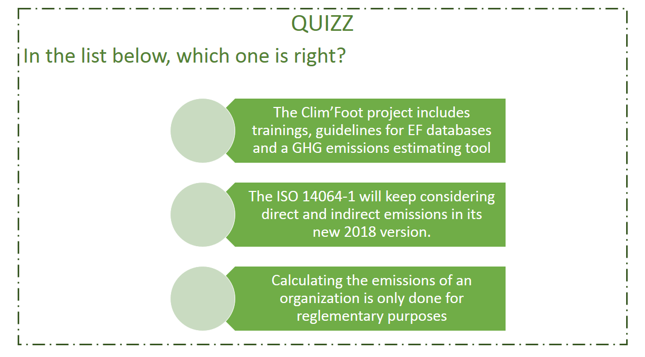- Αρχική
- Clim'Foot
- Κλιματική Αλλαγή: Εισαγωγή & Βασικές Έννοιες
- ΥΠΟΛΟΓΙΣΜΟΣ ΤΟΥ ΑΝΘΡΑΚΑ
- The carbon accounting
The carbon accounting
Why calculate the emissions of your organization?
All the organizations need to reduce their GHG emissions: when countries take engagements, reglementary changes can be awaited. At a minimum, every organization have to follow this new rules, but they can do better and think ahead: calculate their GHG emissions is the starting point from which the organizations can participate to the low-carbon transition.
But where to start? First, you should insure the awareness of your stakeholders. What is exactly the global warming, and why is it a human problem ? Why should everyone be involved in this problematic?
Then, you need to know what emissions you can reduce: estimating your emissions with the Clim’Foot tool, especially calculating your scope 3 emissions, will give you a clear overview about the situation.
Then, you will have to prove your efforts. In order to do that, the calculation methodology has to be shared between all the stakeholders. That is the main point of the Clim’Foot project: share between European partners a common methodology in emission factor (EF) database creation, in GHG emissions estimating and in emission reduction action plan implementation.
GHG accounting, at the core of low-carbon transition
International context and standardization
The standard ISO 14064-1:2006, drafted by the ISO/TC207 "environmental management" technical committee, specifies the principles and requirements for quantification and for the drafting of reports on greenhouse gas emissions and their elimination for organizations. This "generalist" standard, published in 2006, covers the principles of the GHG protocol.
France proposed its revision, and this was accepted to the tune of more than 80% (voted on in September 2013). This work began in January 2014 in the framework of the TC207/SC7/WG4 and is led by France (President and Secretary).
The contents of the revision will be based on the ISO 14069 Technical Report, available since April 2013. The objective of this technical guide is to help users in the application of the ISO 14064-1 standard by way of guidelines and examples in order to ensure transparency in the quantification of emissions and elimination of GHG in organizations and in the drafting of their reports. In addition, it provides a listing of the emission categories within each scope.
Objective of carbon accounting for the Clim’Foot project
The project brief includes a web-based platform to allow the five participating countries to share the toolboxes developed in each country.
National tool boxes will provide :
-
training in carbon accounting for ADEME counterpart agencies (methodological principles, assistance in gathering and calculating emission factors, and in creating a national carbon database; feedback on the implementation of a dynamic network, whether voluntary or mandatory)
-
training to enable companies and local authorities to become familiar with carbon accounting and its key methodologies
-
establishment of guidelines for the elaboration, management and governance of four national EF databases, for the countries of Italy, Greece, Croatia and Hungary
-
creation of a joint search engine open to all European companies and local authorities, to pool data.
If you are an organisation (end-user), click here to see the Clim'Foot database.
If you are a policy maker, you can discover 5 practical cases for the creation of EF database, discover the Clim'Foot trainings, the Clim'Foot calculation tool, the voluntary programs launched by all countries.

